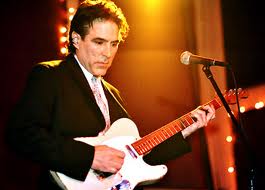by Jim Campilongo
The best Rockabilly players know how to spin jazzy lines over simple blues progressions. Let’s see how this works.
Start by recording Guitar 2 (see chart below), a basstring rockabilly riff designed to drive a 12-bar blues progression in G. For now, choose a moderate tempo. Play through Guitar 2 at least four or five times so you have a long backing track.
Next, start working out Guitar 1, a 12-bar solo that you can play over the backing riff. As we’ll soon see, this single-note line implies a number of chords other than the original I-IV-V changes. Begin slowly, digesting one or two bars at a time. Finally, hook all the phrases together and play the passage as a single, flowing idea. Some observations:
• The arpeggios in bar 4 suggest a superimposed IIm-V (Am7-D7) cadence.
• The first three beats in bar 6 outline a C#dim7 arpeggio.
• The arpeggios in bars 7 and 8 outline a Imaj7-IIm7-IIIm7-bIIIm7-IIm7 move (Gmaj7-Am7-Bm7-Bbm7-Am7).
• In bar 10, an Ebm9 arpeggio sets up tension against D7.
• The lines in bars 11 and 12 sketch a IIIm7-VI7-IIm7-V7 (Bm7-E7-Am7-D7 ) progression over the tonic G harmony.
Go easy. This solo shows how, even when the band is chugging out a “low IQ” progression, you can imply more sophisticated changes with your single-note lines. However, this example is a bit heavy handed. Superimposed harmonic colors sound most effective when you use them sparingly. When you wedge such jazzy ideas between double-stops and pentatonic phrases, your “nasty” will sound nastier and your “sweet” will sound sweeter. Read on for the guitar lesson including audio, chart, and power tab…
Guitar Lesson
http://truefire.com/audio-guitar-lessons/rockabilly-jazz.mp3
Click here to download the Power Tab for this guitar lesson.
